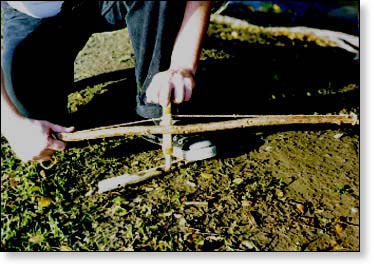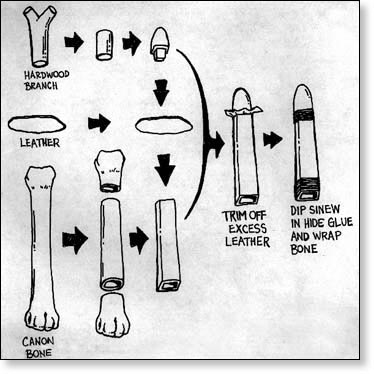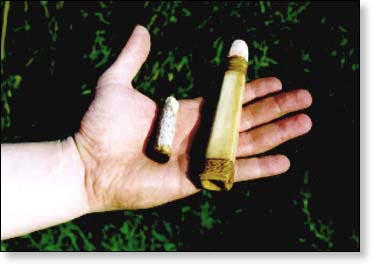
Wood everywhere, but never long enough for a spindle for my fire bow drill. Creating fire by friction is never easy and finding the right materials are never always available. When all you have are short pieces of wooden spindles, then what do you do? The solution can be found in a simple device called the spindle extension. The bone device allows you to attach a short, wooden spindle to create that precious ember. It is very effective and very efficient.

The materials you will need:
1. Canon bone (preferably a deer)
2. Any hardwood from a branch
3. Soft leather
4. Hide glue
5. Sinew (not artificial, although it can still be used)
6. Tools: hacksaw and files (if you prefer to go totally primitive, which will take longer to construct, then you'll need a sandstone block for abrading and a hard stone, like chert or flint, with an edge for sawing)

Cut off the ends of the canon bone, which should leave you about 5 inches of bone. The bone will have 2 openings on both ends. Proceed to square the sides of the exterior of the bone by grinding it on a sandstone block or use a file. Grind the bone exterior to the shape of a long rectangle (tapered, due to the natural shape of the bone). The 4 sides do not have to be perfectly flat and free of natural indentations. As long as the overall shape is rectangular. A trick to get the rectangular shape is to silhouette the bone against a fire or lamp. You'll see where all the irregularities of the shape are located. Grind out the lumps and uneven sides until you come close to a rectangular form. Then use a small flat file to square the inside of both openings of the bone. If you can find a small abrasive stone, you can abrade the inside of the bone instead. Note: Don't grind the bone too thin or it will crack.
Proceed to carve the wood into a cone shape with a flat bottom that has the shape of an angular plug. The wooden plug will fit into the narrow end of the bone spindle.
Take the soft leather, place it on top of the narrow end of the bone, and position the plug end of the wooden cone on top of the leather. Push down on the wooden cone, wedging it into the bone spindle. This will create a temporary, yet secured, wooden cone that could be replaced in case the wood wears down. Be careful during this procedure because it can crack the end of the bone. NOTE: It might be wise to FIRST wrap the sinew onto the bone ends and let it dry, as discussed in the next paragraph, to prevent the bone from cracking while you're inserting the wooden cone. When done, trim off any excess leather sticking out of the bone.
Dip your index finger and thumb in hide glue and drag the sinew between your fingers. Wrap the narrow end of the bone several times with the sinew soaked with hide glue. Proceed to wrap the larger end of the bone with sinew also. Let the hide glue dry. Your spindle extension is now ready to use.

The advantages of the spindle extension:
1) You can use wood that are too short for a complete wooden spindle. Just cut a piece about 2" to 2 1/2" long, taper and square off one end. Then stick it into the wide end of the bone spindle extension.
2) The rectangular shape of the bone grips the bow string very well (no slippage). Unlike round wooden spindles, the pressure from the string will eventually dent the exterior surface of your wooden spindle causing warping of the wood and slippage of the string. The bone extension will never dent from the string.
Short wooden branches everywhere and an ember is ready to be coaxed out of the hearthboard with my spindle extension.
The original pictorial idea came from Kennie Sherron of Ponca City, Oklahoma.
This article was first published in Wilderness
Way magazine (Volume 4, Issue 1)
E-mail your comments to "Dino Labiste" at KahikoArts@yahoo.comm
E-mail questions answered
about fire-by-friction.
We hope the information on the PrimitiveWays website is both instructional and enjoyable. Understand that no warranty or guarantee is included. We expect adults to act responsibly and children to be supervised by a responsible adult. If you use the information on this site to create your own projects or if you try techniques described on PrimitiveWays, behave in accordance with applicable laws, and think about the sustainability of natural resources. Using tools or techniques described on PrimitiveWays can be dangerous with exposure to heavy, sharp or pointed objects, fire, stone tools and hazards present in outdoor settings. Without proper care and caution, or if done incorrectly, there is a risk of property damage, personal injury or even death. So, be advised: Anyone using any information provided on the PrimitiveWays website assumes responsibility for using proper care and caution to protect property, the life, health and safety of himself or herself and all others. He or she expressly assumes all risk of harm or damage to all persons or property proximately caused by the use of this information.
© PrimitiveWays 2013